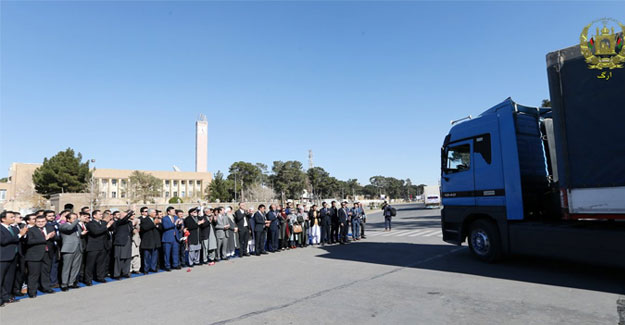Lapis Lazuli Project To Create Vibrant Transit Route For Afghanistan
Lapis Lazuli transit route is set to emerge as an economic corridor for an inclusive development by which Afghanistan could connect to Europe via Turkmenistan, Azerbaijan, Georgia and Turkey.
The first track of Lapis Lazuli project was inaugurated by President of Afghanistan, Mohammad Ashraf Ghani in Herat, Afghanistan on 13 December, 2018. The first shipment of Afghan products which include more than 175 tons of cotton, dried fruit and sesame will be exported through the route within the frame of TIR Carnet.
The trans-regional corridor will encompass mainly railways and highways, which will connect the city of Torghundi in the Afghan province of Herat with the port of Turkmenbashi on the shore of the Caspian Sea via Ashgabat.
On the sidelines of Regional Economic Cooperation Conference on Afghanistan (RECCA- VII), the Lapis Lazuli Agreement was signed in November, 2017 aiming to establish greater connectivity for enhancing trade in the RECCA region. The Lapis Lazuli Corridor will connect with Turkey's Middle Corridor Project and will also compliment other regional transport corridors such as the Five Nations Railway Corridor.
The Lapis Lazuli corridor's key priorities under the initiative in the medium to long term include:
- Improving road conditions and transit facilities along major highways
- Expanding rail links between Afghanistan and Turkey and beyond
- Improving multi-modal land ports in priority places in each of the five Lapis Lazuli Route countries
- Undertaking a Cost-Benefit Analysis on establishing Cross-Border Economic Zones between the countries along the corridor.
The Lapis Lazuli corridor is funded by the Asian Development Bank (ADB). The cost of the project is estimated to exceed US$ 2 billion.
Connecting to India and beyond
Transit access through Pakistan is limited for Afghanistan to reach Indian market and the Afghanistan-Pakistan Transit Trade Agreement (APTTA) did not attribute considerable result as Pakistan did not allow India to join APTTA, thereby creating a hurdle for exporting Afghan goods to the regional countries like India. Afghanistan has now set an ambitious target in creating alternative ways reaching the global market.
The Lapis Lazuli transit corridor aims to lower trade barriers, reduce transaction costs, improve cross-border governance through harmonisation, increase trade and transit and enhance regional cooperation.
The corridor will function under the framework of Transport International Routier (TIR) carnet. The TIR carnet eases the custom procedures and considered as a universal transit system.
Afghanistan became the member of TIR in 1975, however, due to the ongoing instability it was in dormant stage and renewed its membership in 2013. The implementation of the TIR system in the Lapis Lazuli corridor will augment the trade and transit in Afghanistan and other regional countries.
India is a potentially huge market for Afghanistan. If India shows interest in joining the Lapis Lazuli transit corridor it will boost the intra-regional trade value in the context of growing regional share in global trade.
Afghanistan's Improved Regional Trade and Transit- a Way Forward for Development
Over the years Afghanistan's intra-regional trade has steadily increased with Central Asia, India, Iran and Pakistan. The intra-regional trade of Afghanistan stands at 43.1%.
As per the World Bank ranking, Afghanistan's improved status from 183 to 167 in 2018, echoes effort of increasing trade through various fundamental reforms. So far the government of Afghanistan has managed to establish 13 industrial units in 11 provinces.
There are promising developing transit routes like the Five Nation Railway project, Four Nation Railway project, Zyedan-Delaram road (Chabahar project), Belt and Road Initiative (BRI) between Afghanistan and China, Afghanistan-India Air Corridor programme.
The Five Nation Railway project has the potential to connect with China and Iran over a distance of 2100 kilometers and traversing the countries of Kyrgyz Republic, Tajikistan and Afghanistan. The establishment of the multinational railway project is about 50% complete.
The National Ring project which is an important national strategic corridor helps to connect with other provinces in Afghanistan as well as with its neighbours in Central Asia, South Asia, and the Middle East. The Asian Development Bank's (ADB) is supporting National Ring Road of US$ 330 million.
BRI is a regional economic trade and infrastructure platform, aimed at building connectivity between China and the rest of Eurasia. The Belt and Road Initiative between Afghanistan and China was signed in 2015. The work is in progress.
The Trans-Hindukush Road Connectivity is underway and implemented since 2016.
The aim of this corridor is to establish connectivity in the HinduKush mountain range by building road. The project is under procurement plan stage starting from 2016 till 2019.
To expand trade links between Afghanistan and India air connectivity programme was launched in 2017. So far more than 155 cargo flights have been exchanged between Afghanistan and India.
Textile Excellence
Previous News
nonwovens industry pledges uptake in use of recycled pet
Next News
transparent, self-adhesive textile shades windows









